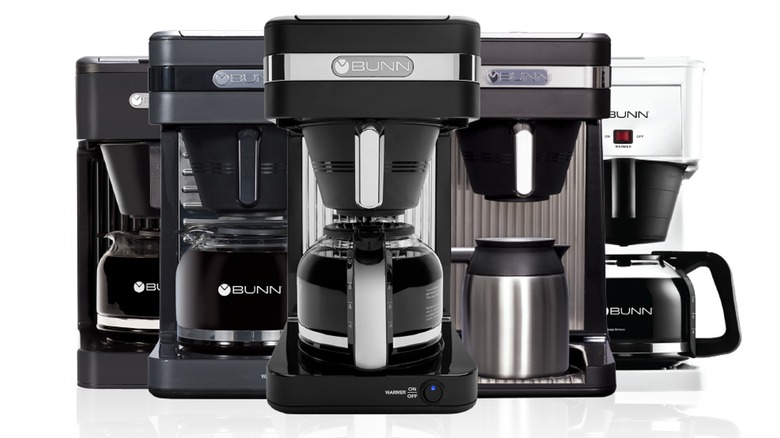How To Clean A Bunn Coffee Maker And Make Every Cup Sing
Throughout the work week, 80% of daily coffee consumers in America enjoy two or more servings at home each day, according to a survey from Statista Consumer Insights. But such frequent consumption for home brewers requires regular maintenance. You should be cleaning your coffee maker more often than you think. It's never too late to start, though, and if you're a BUNN owner, you can learn the most effective strategy from the company itself.
On YouTube, BUNN has a video showing how to clean a My Café coffee maker. To begin, slide one of the drawers into the machine, and open the top lid. "Next, you'll want to measure 14 ounces of white vinegar, and then pour the vinegar into the brewer," the video continues. Afterward, shut the lid, place a cup where the coffee normally comes out (make sure the cup is large enough to hold all that vinegar), and push brew as if you were making coffee. To ensure your next cup of coffee doesn't taste like vinegar, you should run a cycle of plain water through the machine after the vinegar to flush it out.
If your coffee maker uses a filter, you should remove the funnel that holds the filter and rinse it individually. Then you should scrub down any other parts, including the spray head. To polish it off, run water through the machine and thoroughly clean the exterior. This can be done with baking soda, lemon, vinegar, or another food-safe solution.
How frequently should I clean my coffee maker?
Frequent coffee drinkers should understandably clean their machines more than casual users. If you're the former, you should give your BUNN an intensive scrubdown once a month. If coffee isn't in your daily routine, you can push back cleaning to once every three to six months.
Every time you use your machine, though, you should wipe it down, throw away leftover grounds, and make sure the water reservoir is dry. "It's possible for molds and yeasts to form over time in a high moisture environment that can't necessarily be removed with just hot water," Safe Plates director of outreach Ellen Shumaker, Ph.D., said to Everyday Health. After making your last cup of the day, you should hand-wash the messier attachments or put them in the dishwasher for cleaning.
When your coffee maker is maintained properly, it produces a more flavorful cup of coffee, operates quicker and more effectively, and prevents any buildup of allergens and other germs. If these contaminants aren't removed, "some of [the] organisms can lead to allergies or possibly other illnesses," Shumaker said. This could be one of the grossest things about your coffee maker that makes you squirm.

